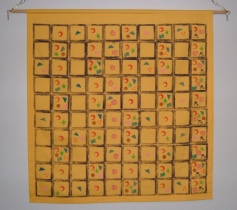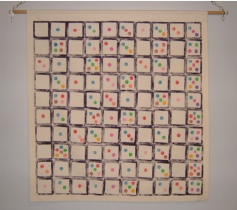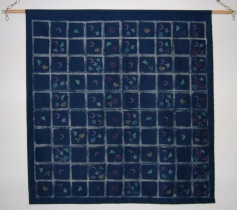
©Pat Ashforth & Steve Plummer 2019


COUNTING PANES
Click for larger pictures



Printed Counting Panes are an adaptation of our highly acclaimed knitted Counting Pane. The original knitted version, which was made in 1996, was bought by the Mathematics Collection of the Science Museum (London). We have since made two more knitted Counting Panes which have frequently been exhibited throughout UK and featured in Educational, Craft, and Science magazines and web sites.
A knitted Counting Pane takes over 100 hours to make so we now sell a booklet of instructions for anyone wanting to make their own .... and hand-
|
|
What does Counting Pane show? Counting Pane shows all multiplication tables up to 10 |
|
|
What is Counting Pane for? It helps children see patterns in numbers and understand multiplication tables, in an informal situation. For adults, it is an original art work with a mathematical message. |
|
|
Why are there 100 squares in the grid? The squares represent the numbers 1 to 100. The squares across the top row represent 1 to 10, those on the second row 11 to 20, and so on. |
|
|
How does it work? Symbols stand for the different multiplication tables. For example, in the yellow Counting Pane (above):
|
|
How is this described mathematically? The numbers that appear in a multiplication table are called multiples. A number that will divide exactly into another number is called a divisor or factor. For example:
|
|
Why are some squares empty? The empty squares are prime numbers. A prime number is a number that will only divide by itself and 1. Special notes:
|
The Mathematics
|
|
How are the prints made? The prints are made individually by hand. Every symbol is applied separately. |
|
|
What are they made from? Fabrics vary but all are heavy weight so that they can be hung without framing. |
|
|
How do I hang my print? Each print has a channel at the top for a pole to be inserted. Poles have been left exposed in the large photos, merely to show their position. You could use:
|
|
What size is the print? The printed area is approximately 94 cm square. The overall size is approximately 100 cm square. |
|
|
Can the print be framed? Most people prefer the print unframed, because of its size but, as the edges are neatly finished before the hem is machine stitched, it would be very easy to undo the stitching and frame the print. It could also be stretched over a simple frame and stapled in place on the back. |
|
|
Why are there different symbols on different prints? It is important that there are ten easily distinguishable symbols. Any set of symbols can be applied to any background. |
|
|
What colours can I have? Again, it is very important that the symbols are easy to identify. Backgrounds and printed colours have to work together to make this possible. Contact us if you have any particular requirements. |
|
|
Can I buy the actual print I see in the photo? We do not currently have any prints for sale. |
The Prints
| Curve of Pursuit |
| Magician's Chain |
| Klein Bottle |
| Square To Eternity |
| Applique |
| Block Prints |
| Counting Panes |
| Enscriptions |
| Screen Prints |
| Circular Prints |
| Colour effects |
| Halves |
| Illusions |
| Irrationals |
| Pentominoes |
| Weaving Patterns |
| Castor & Pollux |
| Ear-piece |
| Flamingo |
| Golden Earring |
| Penrose |
| Wild Oats |
| Crossover Halves |
| Points of Sail |
| Set Sail |
| Steeplechase Halves |
| Boxed In |
| Hexentricity |
| Holes and Corners |
| Rose Windows |
| Runabout |
| The Other Man's Grass |
| Tripartite |
| Window Pains |
| Irrational Boxes |
| Irrational Flowers |
| Irrational Folds |
| Irrational Roofs |
| Bunch of Fives |
| Moons and Nooms |
| Pentamoons |
| Fleece Basketry |
| Leather Basketry |
| Tickled Pink |
| Willow the Wisp |
| Enscription 1A |
| Enscription 1C |
| Enscription 1D |
| Enscription 1E |
| Enscription 2A |
| Cracking Codes |
| Cross-wise |
| Interference |
| Ring Binders |
| Stitch-work |
| Top-spin |
| To the Point |
| Web of Intrigue |
| Wheels Within Wheels |
| Whirlpools |
| Window Boxes |
| Makeables |
| Mirror Pillar |
| Penrose Table |
| Bracelets |
